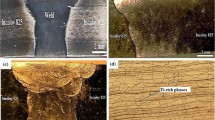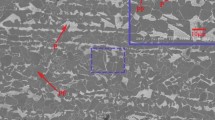Abstract
Weld bead-in-grooves were deposited on low alloy, high strength steel plates (ASTM A 517 Grade “F”) with a commercial flux-cored filler wire, Auto-MIG 420, at different welding conditions. Microstructure and mechanical properties of welds were characterized by means of optical microscopy, SEM, TEM, EPMA, microhardness measurements, tensile tests, and Charpy impact tests. Hydrogen content of weld metals in as-weld condition and after exposing in simulated service condition was measured by LECO Gas Analyzer. Microstructure of weld metals consisted primarily of lath martensite with small amount of M-A constituents (Martensite-Austenite alternating layers). For some particular welding conditions, such as higher heat input and lower preheat temperatures etc., acicular ferrite is observed with lath martensite. Welds consisting of acicular ferrite in the microstructure showed improved mechanical properties as well as lower hydrogen absorption. The study provides guidelines for selecting proper welding conditions, which results in lower propensity to absorb hydrogen during service, as well as better mechanical properties. Necessity of post-weld heat treatment processes, which is mainly performed to achieve toughness, may be reduced; consequently saving cost and time of the welding process.















Similar content being viewed by others
References
O. Grong and D.K. Matlock, Microstructural Development in Mild Steel and Low-Alloy Steel Weld Metals, Int. Met. Rev., 1986, 31(1), p 27–48
J.C.F. Jorge, L.F.G. Souza, and J.M.A. Rebello, The Effect of Chromium on the Microstructure/Toughness Relationship of C-Mn Weld Metal Deposits, Mater. Charact., 2001, 47, p 195–205
B. Dixon and K. Hakansson, Effect of Welding Parameters on Weld Zone Toughness and Hardness in 690 MPa Steel, Weld. Res. Suppl., 1995, 74, p 122s–131s
American Welding Society, Low Alloy Steel, AWS Welding Handbook—Metals and Their Weldability, Sec. 4, 6th ed., American Welding Society, Miami, 1972, p 63.11–63.36
S.D. Bhole, J.B. Nimade, L. Collins, and C. Liu, Effect of Nickel and Molybdenum Additions on Weld Metal Toughness in a Submerged arc Welded HSLA Line Pipe Steel, J. Mater. Process. Technol., 2006, 173, p 92–100
Z. Zhang and R.A. Farrar, Influence of Mn and Ni on the Microstructure and Toughness of C-Mn-Ni Weld Metals, Weld. Res. Suppl., 1997, 76, p 183-s–196-s
J.C. Gonzalez, L.A. de Vedia, and H. Biloni, Development of a High Strength Gas Shielded FCAW Electrode for High Toughness Applications, Vol XII-986-86, Instituto Argentino De Siderurgia, International Institute of Welding, 1986
B. Basu and R. Raman, Microstructural Variations in a High-Strength Structural Steel Weld Under Isoheat Input Conditions, Weld. J. 2002, 81, p 239s–248s
G. Atkins, D. Thiessen, N. Nissley, and Y. Adonyi, Welding Process Effects in Weldability Testing of Steels, Weld. J., 2002, 81, p 61-s–68-s
B.G. Pound, Evaluation of a Diffusion/Trapping Model for Hydrogen Ingress in High Strength Alloys, Annual Report, SRI International, November, 1994
S.K. Albert, V. Ramasubbu, N. Parvathavarthini, and T.P.S. Gill, Influence of Alloying on Hydrogen-Assisted Cracking and Diffusible Hydrogen Content in Cr-Mo Steel Welds, Sadhana, 2003, 28, p 383–393
Y.D. Park, I.S. Maroef, A. Landau, and D.L. Olson, Retained Austenite as a Hydrogen Trap in Steel Welds, Weld. J., 2002, 81, p 27s–35s
J.F. Lancaster, Carbon and Ferritic Alloy Steels, Metallurgy of Welding, 5th ed., Chapman & Hall, London, 1993, p 211
O. Grong, Heat Flow and Temperature Distribution in Welding, Metallurgical Modelling of Welding, The Institute of Materials, London, 1994, p 1–40
O.M. Akselsen and T. Simonsen, Techniques for Examining Transformation Behaviour in Weld Metal and HAZ, Indian Weld. J., 1988, 21, p 344–349
M. Shome and O.N. Mohanty, Continuous Cooling Transformation Diagrams Applicable to the Heat Affected Zone of HSLA-80 and HSLA-100 Steels, Metall. Mater. Trans. A, 2006, 37A, p 2159–2169
S. Shanmugam, N.K. Ramisetti, R.D.K. Misra, J. Hartmann, and S.G. Jansto, Microstructure and High Strength-Toughness Combination of a New 700 MPa Nb-Microalloyed Pipeline Steel, Mater. Sci. Eng. A, 2008, 478, p 26–37
Acknowledgments
The authors are thankful to the Council of Scientific and Industrial Research (CSIR) for sponsoring this research study. The authors also express thanks to Dr. P. C. Chakrabarty, Head of the Department, Metallurgical & Material Engineering Department, Jadavpur University, for his prompt support of instrumental facilities.
Author information
Authors and Affiliations
Corresponding author
Rights and permissions
About this article
Cite this article
Bhattacharya, J., Pal, T.K. Optimal Weld Parameters, Weld Microstructure, Mechanical Properties, and Hydrogen Absorption: An Effective Analysis. J. of Materi Eng and Perform 20, 1336–1345 (2011). https://doi.org/10.1007/s11665-010-9771-5
Received:
Revised:
Published:
Issue Date:
DOI: https://doi.org/10.1007/s11665-010-9771-5




